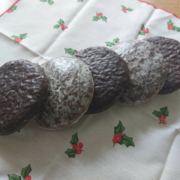Lebkuchen
Lebkuchen is a traditional German Christmas treat which is now also popular abroad, perhaps due to its distinctive nutty, gingerbread-like flavour. Lebkuchen are baked in various shapes, including hearts, but the best known are round and biscuit-sized with white or chocolate glazing on top. Typical ingredients include hazelnuts, walnuts, almonds, orange peel and lemon peel, honey, marzipan, and of course wheat flour, sugar, and eggs, while the spices involved may be cardamom, coriander, cloves, anise, cinnamon, allspice, ginger and mace.
Lebkuchen was created in the 13th century by monks who allowed the sweetened dough to ferment for several weeks before baking it, producing a lighter result. Lebkuchen then flourished in the city of Nuremberg, which today exports Nürnberger Lebkuchen, or Nuremberg Lebkuchen. This particularly popular form of Lebkuchen enjoys a formal protected origin status, so may only use that name when produced within the city of Nuremberg. The German word Kuchen means cake, but the origins of the Leb part of the name are less clear, with multiple root words possible, which refer in turn to bread, honey, life, and the body.
Other well known German festive treats are gluhwein to drink and stollen to eat, and just possibly sauerkraut too alongside other dishes.




